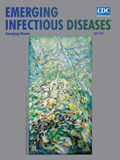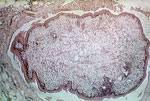
Volume 23, Number 4—April 2017
Etymologia
Etymologia: Sparganosis
On This Page

Figure. Histopathology of Sparganum proliferum infection. Public Image Health Library, Centers for Disease Control, 1962.
Sparganosis (Figure) refers to tissue infection with the pleurocercoid larvae of the genera Diphyllobothrium (from the Greek di [“two”] + phyllon [“leaf”] + bothrion [“pit”]) or Spirometra (from the Greek speira [“coil”] + metra [“uterus”]). Sparganum (from the Greek sparganon [“swaddling clothes”]) was originally described in 1854 by Diesing as a separate species but is now used generically to describe the larval stage of these cestodes.
The first human case was reported by Sir Patrick Manson in China in 1882, and 2 species (S. mansoni and S. mansonoides) are named for him. Sparganosis is most common in Asia where frogs or snakes are more commonly eaten or where traditional medicinal practices call for the use of raw frog or snake meat in poultices, although recent reports indicate it occurs in in some populations in Africa.
References
- Dorland’s Illustrated Medical Dictionary. 32nd ed. Philadelphia: Elsevier Saunders; 2012.
- Eberhard ML, Thiele EA, Yembo GE, Yibi MS, Cama VA, Ruiz-Tiben E. Thirty-seven human cases of sparganosis from Ethiopia and South Sudan caused by Spirometra spp. Am J Trop Med Hyg. 2015;93:350–5. DOIPubMed
- Fantham HB, Stephens JW, Theobald FV. The animal parasites of man. New York: William Wood and Company; 1920.
- Lescano AG, Zunt J. Other cestodes: sparganosis, coenurosis and Taenia crassiceps cysticercosis. Handb Clin Neurol. 2013;114:335–45. DOIPubMed






















.png)











No hay comentarios:
Publicar un comentario